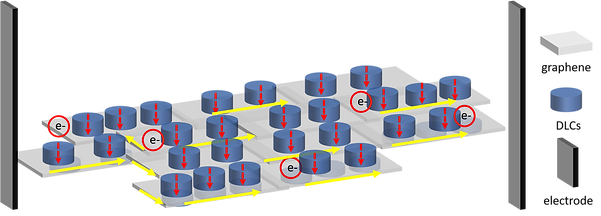
2D Materials
Helical superstructure of discotic liquid crystals (DLCs)
-
Typical ordered phases of calamitic thermotropic liquid crystals

Smectic A

Smectic C
Discotic liquid crystalline (DLCs) molecules compose of a rigid disk-like core covalently attached with flexible side chains, where the rigid core provides crystalline character and the surrounding flexible side chains cause the liquid-like nature of the mesophase.

Due to the favorable π-π interaction, discotic molecules usually assemble into one-dimensional columnar structure. In our recent study, a helical column of DLC is proposed via 2D-GIWAXS.

-
The optical microscope image of DLCs, the chevron texture is shown.

-
The proposed model of helical columnar structure
Based on the result of 2D-GIWAXS, the arrangement of DLC columns can be obtained from the diffraction spots at the meridian and equator. Since the periodicity along meridian axis is much larger than the diameter of a columnar superstructure, the involvement of helical variation of long-axis orientation of columnar superstructure is unveiled.

π-π interaction


From electronic images, the chevron-like shape can be observed more clearly, as well as the helical superstructure of DLC.


The binary liquid crystalline phases of 2D materials and selected DLCs
Electronic Devices
Owing to the polycyclic aromatic cores, DLCs are also called “Nano-graphene”, and therefore are promising to yield favorable physical interactions with 2D materials. Hence, the stable suspended solution of graphene is developed(the darker solution).


The success of functionalized graphene sheets offer a novel route to develop the binary ordered phase through the intercalation of 2D materials into DLC crystalline phases, as shown on the illustrated scheme.

High Entropy Materials
The preliminary study of binary phase is also conducted. Based on the 2D-GIWAXS results, the periodicity along the meridian axis is changed. Hence, the functionalized graphene sheets are inferred to intercalate within DLC ordered phase.


The applications of binary liquid crystalline phases
DLCs are found to have good charge transport along the one-dimensional columnar structure. However, due to the insulating aliphatic side chains, the inter-column transportation is less efficient. Therefore, as the continuous stacking of graphene sheets is evolved within LC phases of DLCs, efficient charge transportation within continuous binary LC phase spread through source and drain electrodes is likely to be achieved.

Besides, DLCs are also usually applied to photovoltaic field. Hence, the functionalized graphene sheets are able to serve as the template for charge transportation. The thin-film transistors, heat management materials and radiation resistance materials are possible applications.

According to the molecular structure, DLC molecules could be n-type or p-type semiconductors. The electronic structure of discotic aromatic core is tunable by bandgap engineering such as vis the alteration of substitutive elements of discotic cores, the size and symmetry of discotic core, and selected side chains. Hence, with the exfoliated graphene sheets,we might be able to study the growth of heterogeneous array of donor and accepter.



The scrolling and reverse unwrapped of nanoscrolls

-
About (a) 10 min, (b) 35 min, (c) 60 minutes after the addition of 25 vol % of hexane solvent within graphene suspension solution, morphologic evolution of graphene sheets was observed.
reverse unwrapped


-
With the tranquil stay at room temperature for six days, most of graphene nanoscrolls were fully unwrapped.
The unceasing surface adsorption of P3HT coils is conceived responsible for the progressive improvement of the solvation of graphene nanoscrolls.
The characteristics of graphene nanoscrolls



-
The cross-section SEM image of deposited graphene nanoscrolls during slow solvent evaporation.

-
The calculated bending energy versus the diameter of graphene hemi-cylinder is shown.
According to gained cross-section images of graphene nanoscrolls, the smallest diameter of central void is recognized around 38 nm, which is related to nearby 0.74o bending degree of graphene hexagonal structural units.
The derived interlayer separation is within the range of unperturbed radius of gyration of adsorbed P3HT coils (about 7 nm) and less than five internal layers evolve during initiated self-scrolling.

The growth and hindering effect of comb-like superstructures
Upon the solvent evaporation, the initiated ordering of molecular segments results in dense growth of P3HT crystalline whiskers outward from graphene nanoscrolls, and thus comb-like superstructures evolve.
The observed (020) diffraction arc of comb-like superstructures is related to the lattice packing of P3HT stems along the b axis within crystalline whiskers, which is the direction of p-p stacking. Accordingly, the face-on attachment of P3HT segments on nanoscrolls is identified to occur around nanoscrolls.




-
The optical microscopic images establish the attained alignment uniformity of deposited thread-like domains upon slow solvent evaporation with the inclusion of oriented comb-like superstructures.
When the solvent evaporation undergoes slowly, grown P3HT crystalline whiskers upon homogeneous nucleation were found to align preferably with similar orientations on substrate, resulting in the spread of oriented arrays of crystalline whiskers. Besides, within each region, crystalline whiskers are aligned primarily perpendicular to nanoscroll axis of comb-like superstructures.
.png)
The induced oriented growth of crystalline whiskers around one comb-like superstructure is to enhance the anisotropic hindering effect and expand the field of oriented solvent flow, therefore causing other nearby superstructures to align accordingly.


The formation of thread-like domains is viewed as a result of oriented growth and assembly of crystalline whiskers into anisotropic thread-like nematic domains with the presence of comb-like superstructures.
Conclusion
The presence of anisotropic superstructures upon the dense heterogeneous nucleation and outward growth of P3HT crystalline whiskers from nanoscrolls during evaporation is unveiled able to guide the passing solvent flow, which arrays the growth of nematic domains of P3HT crystalline whiskers.

